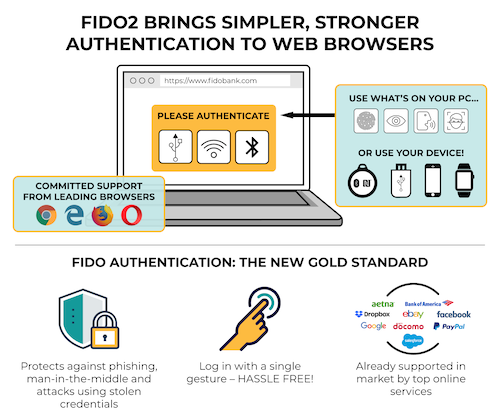W3C Strategic Highlights
May 2018
This report was prepared for the May 2018 W3C Advisory Committee Meeting (W3C Member link). See the accompanying W3C Fact Sheet — May 2018. For the previous edition, see the November 2017 W3C Strategic Highlights. For future editions of this report, please consult the latest version.
A Chinese translation is available.
Introduction
This report gives an overview of recent highlights and work of consolidation, optimization, enhancement of the existing landscape, innovation, incubation, research, and the 2018 W3C Road-map for the Web.
![Core innovation [Lightbulb design credit: Freepik]](https://www.w3.org/2017/Talks/tpac-slides/tpac2017-jeff/Pictures/coreinnovation.jpg)
W3C's work enables the Web to scale to meet the new challenges and opportunities while selected technologies and features continue to give way to incredible core innovation once again. Progress in many areas demonstrates both the vitality of the W3C and the Web community. We see the maturation and further development of an incredible number of new technology coming to the Web:
- WOFF2 (Web Open Font Format) is now a W3C Recommendation.
- Adoption of streamlined payment solutions on the Web by merchant sites (Web Payments work is currently in Candidate Recommendation).
- Bringing virtual reality on the Web by exploring work stemming from existing W3C Community Group work and leveraging the recent W3C workshops (1), (2).
- Advancing WebAssembly whose first public drafts were released in mid-February and which promises to improve the performance and power of the Web by allowing loaded pages to run compiled native code.
- Service Workers has now been implemented across the platform.
2018 sees the first normative update in a decade of the Web Content Accessibility Guidelines as WCAG 2.1 will become a W3C Recommendation early June. WCAG 2 has an incredible influence; having been adopted as a regulatory requirement in various countries, and also used widely for business and non-governmental sites, the same is anticipated for WCAG 2.1. Moreover, the European Union is poised to fully adopt WCAG 2.1 during the Summer in its revision of EN 301 549, the Directive for "Accessibility requirements suitable for public procurement of ICT products and services in Europe".
Telecommunications opportunities for the Web. WebRTC is now a cornerstone of the telecommunications industry, that the W3C is extending by adding features such as peer-to-peer data exchange for finalization in 2018. W3C organized the May 2018 Web5G workshop hoping to address under a Web5G plan the opportunities for the Web created by the planned deployment of 5G networks: higher bandwidth, lower latency and better coverage.
Web Authentication at Candidate Recommendation. Proposing to tackle part of the vast security problem on the Internet by eliminating password-dependence. Passwords can be stolen and are frequently reused on many sites, but the Web Authentication API, released in the Spring as a W3C Candidate Recommendation (i.e., feature-complete), provides non-phishable authentication through user-controlled authenticators with site-specific credentials based on public key cryptography.
Testing the Web. The Web Platform Tests suite – a project W3C and its members have given a lot of attention and resources – continues to be very active. The web-platform-tests dashboard, first delivered in 2017 following the integration of automatic generation of test results, will provide a daily snapshot of the evolution of Web interoperability, with continuous improvement. The WebDriver specification, now a W3C Proposed Recommendation which will become a W3C Recommendation in late May, will complement this project by adding additional automatic tests of Web browsers to improve interoperability.
Collaboration with the WHATWG. W3C has been exploring effective partnership mechanisms with the WHATWG for HTML and DOM – a continuation of past efforts – since their recent adoption of a work mode similar to the W3C's.
- We see positive elements in the WHATWG changes, in particular adoption of a patent policy, of a code of conduct and the attribution license CC-BY. We've been in conversation with WHATWG to determine how we can work together in a way that maintains the enduring social values of the W3C including giving all stakeholders and the nearly 500 W3C members seats at the decision table.
- Since December, we have had several direct meetings with the WHATWG Steering Group; tone has been positive although progress is slow.
- W3C remains committed to ensuring that HTML development continues to take into account the needs of the global community, and continues to improve in areas such as accessibility, internationalization and privacy while providing greater interoperability, performance and security.
Future Web Standards
W3C has a variety of mechanisms for listening to what the community thinks could become good future Web standards. These include discussions with the Membership, discussions with other standards bodies, and the activities of thousands of participants in over 300 community groups. There are lots of good ideas. The W3C strategy team has been identifying promising topics and invites public participation.
The Strategy Funnel documents the staff's exploration of potential new work at various phases: Exploration and Investigation, Incubation and Evaluation, and eventually to the chartering of a new standards group. The Funnel view is a GitHub Project in which each new area is an issue represented by a “card” in the stack which move through the columns, usually from left to right. Most issues (cards) start in Exploration and move towards Chartering, or move out of the funnel.
Public input is welcome at any stage but particularly once Incubation has begun. This helps W3C identify work that is sufficiently incubated to warrant standardization, to review the ecosystem around the work and indicate interest in participating in its standardization, and then to draft a charter that reflects an appropriate scope. Ongoing feedback can speed up the overall standardization process.
Since the previous highlights document, W3C has chartered a number of groups:
Rechartered
- Pointer Events Working Group
- Second Screen Working Group
- Privacy Interest Group
- Web Payments Working Group
- WAI Interest Group
- Automotive Working Group
Extended
- Web Real-Time Communications Working Group
- Device and Sensors Working Group
- Tracking Protection Working Group
- Internationalization (I18n) Groups
- Browser Testing and Tools Working Group
- Efficient Extensible Interchange Working Group
Concluded
- Social Web Working Group
- Semantic Web Health Care and Life Sciences Interest Group
- Permissions & Obligations Expression Working Group
Under Review
- Distributed Tracing WG
- JSON-LD WG
- Device and Sensors WG re-charter
- Timed Text WG re-charter
Workshops
The Strategy Team is considering a number of workshops, on topics including: Permissions and Capabilities; Manga, Comics, Bandes Dessinées - Fixed Layout; Strong Identity; Evolving the Web Platform; Coupons; and Improving Web Advertising.
Strengthening the Core of the Web
CSS
All CSS specifications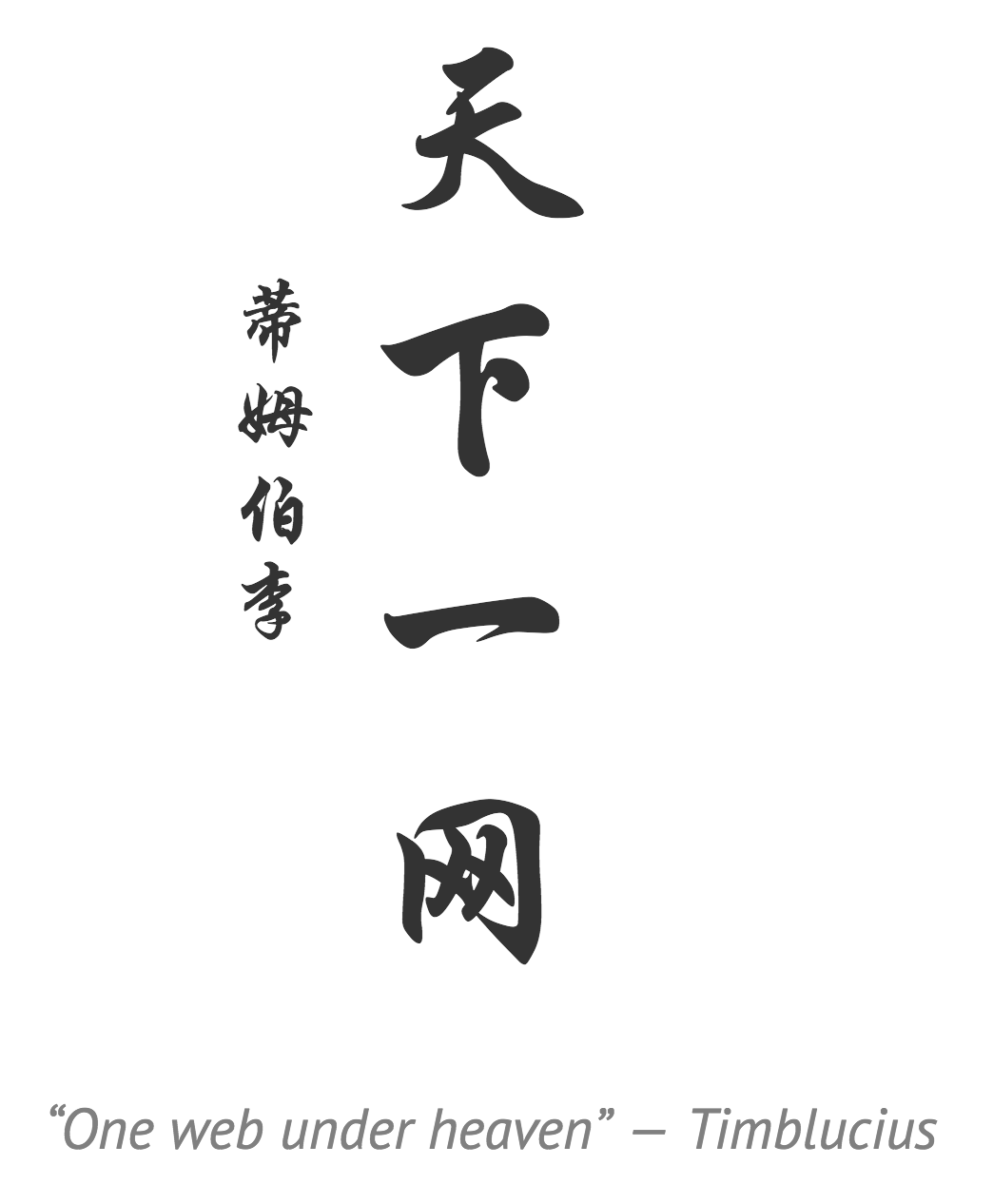
Recent focus of the CSS Working Group is around flexbox and grid layout, CSS for user interfaces, improved fonts support and the publication of CSS Snapshot 2018, a collection under one definition of all the specifications that form the current state of Cascading Style Sheets (CSS).
The Houdini Task Force is a joint effort of the CSS Working Group and the Technical Architecture Group (TAG) to develop features that remove the “magic” of Styling and Layout on the Web, making it available for scripting extensions. Current highlights:
- Improved Object Model for CSS
- Custom Layout and Paint
- Worklets and animation
The CSS Working Group gathers requirements from two large groups of CSS users: the publishing industry and application developers. Within W3C, those groups are exemplified by the Publishing groups and the Web Platform Working Group. The former requires things like better pagination support and advanced font handling, the latter needs intelligent (and fast!) scrolling and animations.
What we know as CSS is actually a collection of almost a hundred specifications, referred to as ‘modules’. Even for a big working group like CSS, developing such an extensive technology is stretching its resources. We are looking for:
- experts for new features, including typography of countries where W3C has few members, and new technologies such as variable fonts, color fonts and hardware-accelerated graphics.
- talented people to do quality management, in particular to isolate all assertions made in a CSS modules, make sure there are tests for them, and check the accuracy of those tests.
- The group has good support from the traditional implementers, i.e., browser makers, but is always looking for implementers of other types of software (of which there are many).
SVG
The SVG Working Group rechartered last Summer with a focus on stabilization of already deployed features, and accessibility improvements. Some new tests have been committed and the group is meeting regularly by telephone. Browser vendors and other implementors are committed to improving interoperability.
HTML
All specifications tagged 'HTML'Headed to become a Candidate Recommendation towards the Summer, HTML 5.3
provides better integration with specifications like Referrer Policy,
CSP 3 and the Payment Request API (i.e. “allowpaymentrequest”
in <iframe>). The Custom Elements APIs, which allow authors to define and use new types of DOM elements in a document, have been incorporated into HTML 5.3 with implementation evidence.
Testing
Browser testing plays a critical role in the growth of the Web by:
- Improving the reliability of Web technology definitions;
- Improving the quality of implementations of these technologies by helping vendors to detect bugs in their products;
- Improving the data available to Web developers on known bugs and deficiencies of Web technologies by publishing results of these tests.
Since 2014 W3C began work on a coordinated open-source effort to build a cross-browser test suite for the Web Platform: Web-Platform-Tests. Web-Platform Test has been adopted by W3C, WHATWG, and all major browsers. The project is discussing the establishment of a revert policy and is in the process of moving to a new GitHub organization.
After integrating automatic generation of test results, the project released the web-platform-tests dashboard, making it easier to identify and fix interoperability issues, and aiming to provide a daily view of the Web interoperability. Improvements for this dashboard are still ongoing.
A key piece of testing automation is to be able to "run the browser" programmatically, without manual interaction. The Browser Testing and Tools Working Group advanced the Web Driver specification to Proposed Recommendation in the Spring. It will allow additional automatic testing of Web browsers to improve interoperability.
Performance
WebAssembly
All WebAssembly specifications
WebAssembly improves Web performance and power by enabling loaded pages to run native (compiled) code.
Since its launch in the Summer 2017, the WebAssembly Working Group has published the First Public Working Drafts of the Core Specification, the JavaScript Interface and the Web API. Read the article on SD Times.
All major browsers — Chrome, Edge, Firefox, and WebKit — are implementing the specification, a reflection of community excitement as well as viability of the approach. The work is divided between the Community Group (969 members) and the Working Group (41 members). Feature prioritization and technology development occurs in the CG; test production and Recommendation Track documents are developed in the WG.
Web Performance
All Web Performance specifications
The Web Performance Working Group continues to make progress with its deliverables, continues conversation around the life cycle of Web applications, and keeps refining the performance timeline and the various information available to evaluate the performance of Web applications.
The Server Timing specification, which allows web servers to pass performance timing information via HTTP headers to browsers, is starting to get implementations. This API enables developers to schedule background tasks to execute when the Web browser would otherwise be idle.
Beacon, which allows to schedule asynchronous and non-blocking delivery of data, has now been implemented across the platform.
The Meltdown and Spectre issues affected the accuracy of the high resolution timer provided by the Performance object. The Working Group continues to evaluate the situation for proper guidance.
Web of Data

One of the challenges for organizations is integration of information systems given the demand for agility in coping with changing requirements and the increasing range and quantity of data available in a variety of formats. The mission of W3C's Data Activity is to overcome the lack of data models and common vocabularies, and facilitate potentially Web-scale data integration and processing, by providing standard data exchange formats, models, tools, and guidance. This builds upon W3C’s previous work on RDF and Linked Data, and the corresponding suite of W3C Recommendations, e.g. for RDF, OWL, and SPARQL.
There is a relationship to the Web of Things, where W3C is seeking to define standards for an object model as an abstraction layer over existing IoT standards, using programming language independent descriptions of things and their relationships.
Notable progress in this space:
- The Dataset Exchange Working Group just published their First Public Working Draft of the revised edition of Data Catalog Vocabulary (DCAT).
- The W3C Advisory Committee reviewed in the Spring a proposed JSON-LD Working Group Charter to update JSON-LD 1.0 following the JSON-LD Community Group's progress.
- W3C recently released the results of a study on tooling and practices for web data standardization, and we gratefully acknowledge funding for the study by the Open Data Institute. The next step is further discussions on how to accelerate W3C's role as a venue for developing community standards.
- The Spatial Data on the Web Interest Group, a collaboration with the Open Geospatial Consortium (OGC) has started to develop additional best practices and to evaluate technology proposals that could improve the publication and consumption of spatial data on the Web (see on-going projects within the group)
- W3C/ERCIM is participating in European projects
- "Boost 4.0" on big data in Industry 4.0, where we're responsible for standardization, data governance and certification. The project will field 10 lighthouse and 3 replication pilots across European manufacturers and accelerate the transition to Industry 4.0.
- "SPECIAL" on the role of Linked Data for data privacy controls such as needed for GDPR, the new European regulations for handling personal data.
- A W3C Workshop is at an early stage of planning on taking stock after two decades of experience with RDF and linked data, with a view to identifying the potential for new work items, e.g. the relationship to Property Graphs, digitally signed Linked Data graphs, context sensitive mappings for data across vocabularies with overlapping semantics, and support for Enterprise Knowledge Graphs in relation to Data Governance.
- The Permissions and Obligations Working Group recently closed after bringing to W3C Recommendation the ODRL Vocabulary & Expression and its Information Model.
Meeting Industry Needs
Digital Publishing
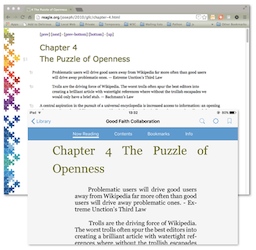
All Digital Publishing Standards and Drafts, Publication status page
The Web is the universal publishing platform. Publishing is increasingly impacted by the Web, and the Web increasingly impacts Publishing.
Topic of particular interest to Publishing@W3C include typography and layout, accessibility, usability, portability, distribution, archiving, offline access, print on demand, and reliable cross referencing.
Notable progress in this space:
- The Publishing Working Group having published last Winter a set of First Public Working Drafts for Web Publications, Packaged Web Publications, and Web Annotation Extensions for Web Publications now focuses on relationships to Web Packaging, to Web Application Manifests (would a Web Publication Manifest build on top of it or would be its own format?), and concentrates on defining UA publication specific “affordances”.
- The Publishing Business Group recently updated its charter and mode of operation, set up a number of task forces covering fields like Accessibility, EPUB 3 deployment issues, and relationships to ISO standardization activities; and is setting up a mechanism whereby interested parties could contribute to the continuing development of EpubCheck.
- The EPUB 3 Community Group continues the development and maintenance of the current version of EPUB 3.
To alleviate the problems created by backward compatibility issues, the specification editors proposed to roll back some of the changes in EPUB 3.1. This updated spec would be known as EPUB 3.2. The group has started work with the explicit goal of remaining compatible with all existing EPUB 3.0.1 files, while retaining the best features of EPUB 3.1.
Read Dave Cramer's W3C Blog post for an overview of the ebook ecosystem and rationale for EPUB 3.2 as well as a call for help to join the EPUB 3 Community Group. It’s free, not limited to W3C members, and everyone is welcome. Much of the discussion of technical issues will happen on GitHub.
Web Payments
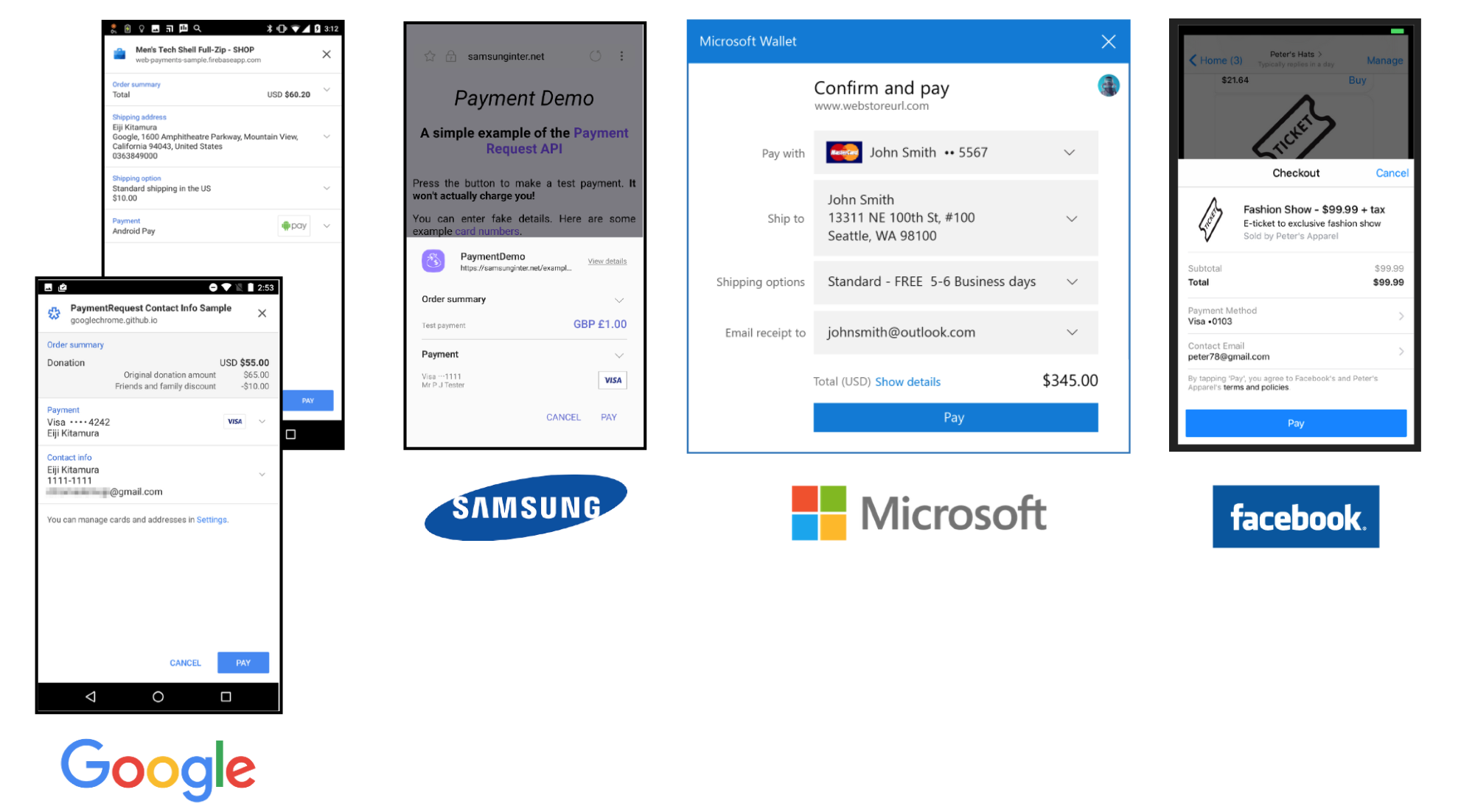
All Web Payments specifications
All major browsers are now implementing Payment Request API to enable streamlined checkout.
Work continues to increase payment security (e.g., through tokenization) and to enable Web-based payment apps. Task forces within the Web Payments Working Group are discussing ways to increase payment security, including looking at encryption, tokenization, enabling 3D Secure flows through Payment Request API. A task force is also looking at credit transfers, especially in light of Payment Services Directive 2 (PSD2) in Europe.
In March 2018 the group began to operate under its revised charter. In April 2018, following a face-to-face meeting in Singapore, the group's co-Chairs updated the group's priorities for the next year:
- Close issues for Payment Request API and Payment Method Identifiers, complete the test suite, demonstrate interoperability of implementations, advance the specifications to Recommendation, and foster merchant adoption.
- Continue to refine Payment Handler API and Payment Method Manifest and push for more implementation in browsers. Identify and work with distributors of Web-based payment apps.
- Develop a shared understanding of the future of strong authentication for Web payments in collaboration with EMVCo and the FIDO Alliance. Determine how to support 3DS2 flows in conjunction with Payment Request.
- Solidify the tokenized card payment method specification through experimentation and encourage deployment in Web-based payment handlers.
- Make progress on push payments (notably credit transfers and perhaps direct debits) in alignment with PSD2 requirements around strong authentication and open banking APIs. This is likely to involve strengthening our liaisons with open API efforts in Europe such as Open Banking UK and the Berlin Group.
Implementation experience from Google, Microsoft, Samsung, Mozilla, Opera, Facebook, American Express, Mastercard, Shopify, Stripe, Worldpay, and others is leading to improvements to the Payment Request API and supporting specifications.
A number of companies that provide services to merchants, including Stripe, Braintree, Shopify, BlueSnap, Payone, and WePay, now provide support for Payment Request API in their SDKs.
The Payment Handler API is currently being implemented in Chrome (see Google's intent to ship in Blink), with Mozilla planning to implement as well. This specification adds Web-based payment handlers to the Payment Request ecosystem.
Google has also implemented the Payment Method Manifest specification. This specification enables payment method owners to authorize software from different domains to fulfill the payment method, an important security consideration in the payment app ecosystem.
Media and Entertainment

The Media and Entertainment Interest Group serves as steering committee for the Media and Entertainment activities within W3C to review topics of interest such as TV Control API, Second Screen, Media Capabilities, 360° Videos, Media-Timed Events. The group maintains the Media and Entertainment Road-map. The vision within a year or so is to:
- Reinforce core media technologies:
- Reduce fragmentation:
- Web Media API (collaboration with CTA WAVE), aiming to define a common baseline for HTML5 suitable for Web media applications and corresponding devices (TV sets, set-top boxes, game machines, mobile devices), to help reduce the cost of producing content that works across a variety of devices.
- Media Capabilities detection: supported decoding and encoding capabilities, supported profiles, display capabilities
- Second screen support (enabled by the Presentation API and Remote Playback API. The Second Screen Community Group progresses on discussions of an Open Screen Protocol to improve interoperability between screens across implementations. To be discussed in Berlin during the group's face-to-face meeting right after the AC meeting.
- Capability detection for encrypted content (EME): HDCP detection, Encryption scheme capability detection
- Prepare the future:
- WebXR / 360 videos
- GPU for the Web
Web & Telecommunications

The Web is the Open Platform for Mobile. Telecommunication service providers and network equipment providers have long been critical actors in the deployment of Web technologies to the public at large. The convergence of Web and mobile industries is now fully in march, driven by the convergence of the underlying technologies to IP-based systems. As the Web platform matures, it brings to service providers richer and richer capabilities to extend their existing services to new users and devices, and propose new and innovative services to their subscribers. The April 2018 edition of the Roadmap of Web Applications on Mobile explores the technologies developed in W3C that increase the capabilities of Web applications in mobile contexts.
Now that IT and Telcos industry have converged, more coordination and cooperation is needed. What's next for Telecommunication on the Web?
- Follow-ups to Web5G Workshop (Interest Group, Business Group?);
- Publishing Web Real-Time Communications 1.0 as standard and pushing new 2.0 features to the market;
- Enabling telecommunication operators as identity providers and payment providers for the Web;
- Advancing Web stack for 5G use cases: VR/AR, automotive, Internet of Things, 4K/8K media.
Virtual / Mixed / Augmented Reality → XR

Important milestones last year contributed to making the Web platform great for VR experiences: WebVR 1.1 is now available by default in a few browsers (notably Firefox since its version 55), and as an experimental feature in many more (including Chrome and Edge). In parallel to the development and adoption of WebVR 1.1, a major rewrite of WebVR was started to take into account a number of design issues that had emerged.
2017 was also a year with many announcements enabling more robust usage of Augmented Reality technologies (notably, ARCore and ARKit on mobile operating systems), and the WebVR community eagerly experimented with these new capabilities to see how the Web could become a major platform for augmented reality.
This combination the WebVR specification rewrite and the need to prepare for Augmented and Mixed Reality experiences have led the WebVR Community Group to change its name, reflecting a new scope: it is now known as the Immersive Web Community Group, with a scope encompassing not only Virtual Reality, but also Augmented and Mixed Reality. In the same vein, what had been known as WebVR 2 has now become the WebXR Device API.
Following a Web & VR Workshop in Oct 2016, a workshop focused on Authoring content with WebVR was held in December 2017. The report from that workshop is still being worked on.
Discussions with the Community Group on transitioning that work to the Recommendation track are still ongoing.
Web5G
The planned deployment of 5G, the fifth generation networks, in the upcoming few years is creating a set of challenges and opportunities for the Web Platform to adjust to these new network capabilities: higher bandwidth, lower latency and better coverage than today’s networks – a need the W3C hopes to address under a Web5G plan:
- Important application layer innovation: XR, IoT, automotive, 4K & 8K videos;
- Multiple network and transport layer innovations: 5G, NFV, SDN, MEC, QUIC;
- AI and Machine Learning impact across layers.
Will they work together or against one another?
W3C organized the May 2018 Web5G workshop to gather representatives from telecommunication operators, network equipment vendors, platform and application developers, and browser vendors in order to look at the intersection of the evolution of network- and application- layers.
Real-Time Communications (WebRTC)
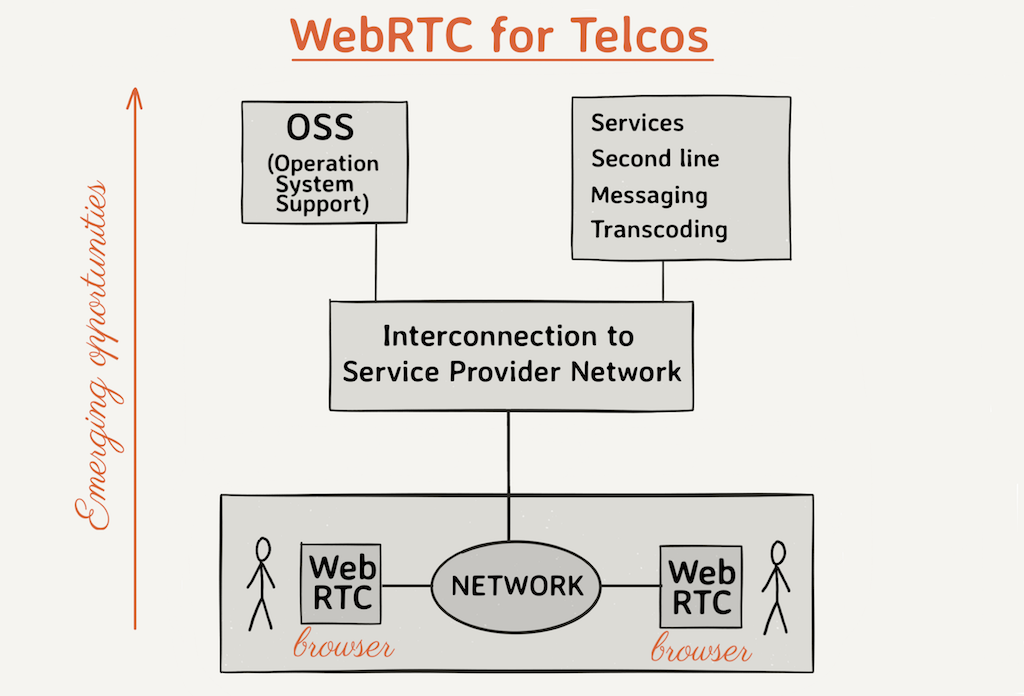
All Real-Time Communications specifications
WebRTC has reshaped the whole communication landscape by making any connected device a potential communication end-point, bringing audio and video communications anywhere, on any network, vastly expanding the ability of operators to reach their customers. WebRTC 1.0 reached Candidate Recommendation last November, indicating the stability of this specification which now serves as a corner-stone of many on-line communication and collaboration services.
The WebRTC Working Group and W3C members are providing input on the future of WebRTC by assessing a new charter to finish existing work and consider new use cases and extensions identified as needed in the existing deployments of the technology.
Web of Things
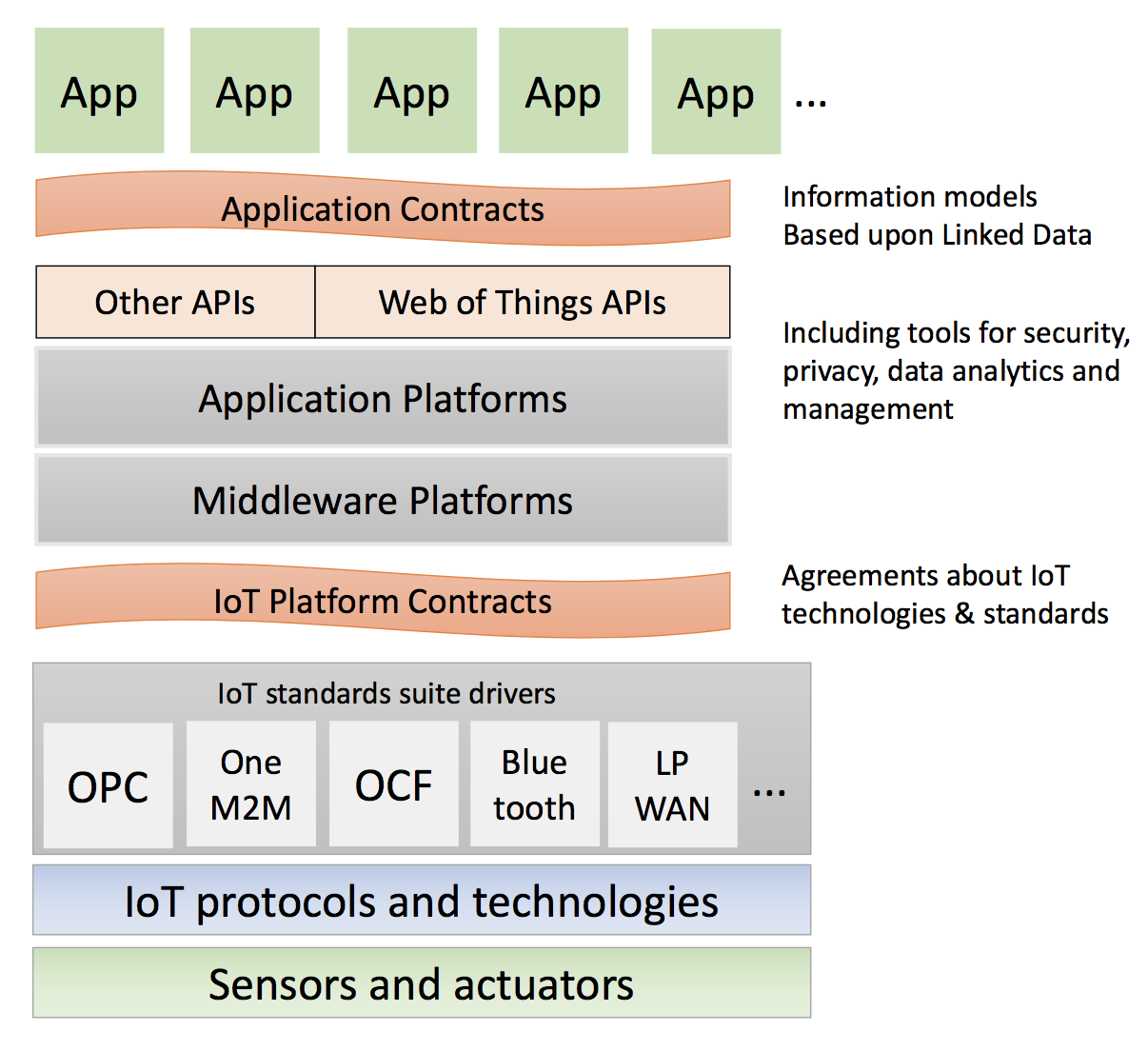
All Web of Things specifications
The Internet of Things creates immense opportunities through connected sensors and actuators, big data, machine learning and integration of services on a Web scale, however fragmentation is limiting the IoT's full potential. An ever increasing number of IoT platforms and technologies with limited interoperability are hindering some investments, making it hard for IoT to reach critical mass.
W3C's Web of Things work is designed to bridge disparate technology stacks to allow devices to work together independent of their underlying technology stack and thus to achieve scale. Primarily, it provides mechanisms to formally describe IoT interfaces to allow IoT devices and services to communicate with each other and across multiple networking protocols. Secondarily, it provides a standardized way to define and program IoT behavior. W3C is focusing on standards for the interface between applications and application platforms, as well as the standards needed to enable open marketplaces on the scale of the Web. By contrast, OCF, oneM2M, Bluetooth, and OPC, are focused on standards for particular IoT platforms.
The Web of Things Working Group develops cross domain standards for thing descriptions, APIs and integration with IoT platforms in collaboration with the corresponding organizations, and is looking for help from industry experts in regards to use cases, API design, security and semantic modeling, as well as people involved in standards for IoT platforms.
Notable progress in this space:
- Updated Working Drafts on using JSON-LD for thing descriptions, the Web of Things architecture, and a scripting API for Web of Things application platforms, all expected to advance to W3C Candidate Recommendations by the end of 2018.
- Recently the group started work on simpler use of JSON for thing descriptions with a focus on attracting Web developers interested in smart home applications.
Automotive
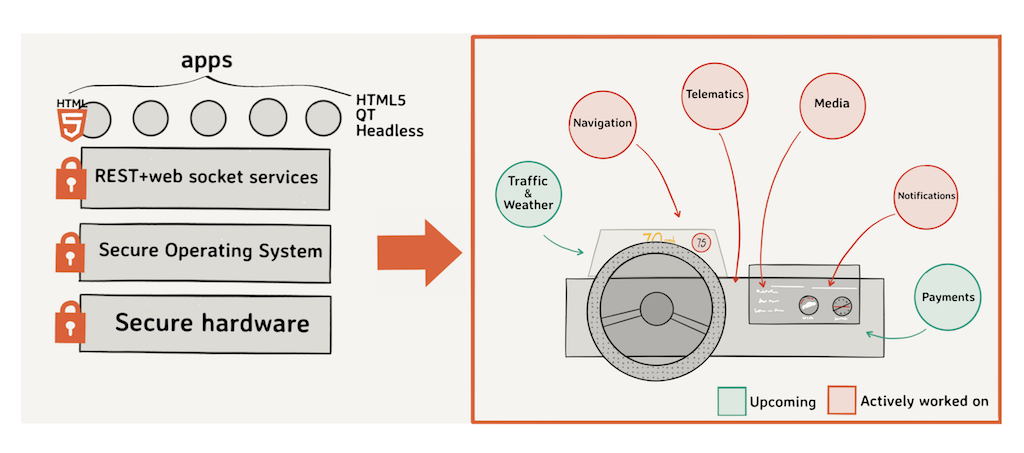
The W3C Automotive Working Group is working to deliver a service specification for exposing vehicle signals (fuel level, speed, engine temperature, etc.):
- The Vehicle Information Service Specification (VISS) advanced to Candidate Recommendation, has implementation and a test suite.
- The working group published Vehicle Information API Specification (VIAS) as a Note and encourage an open source Javascript library implementation.
This service approach has a number of advantages over an earlier WebIDL-based approach including being usable by both QT and HTML5 developers as well as headless applications running on the vehicle. It is also similar to how others in the industry have been approaching exposing vehicle signals. The Volkswagen Group joined W3C and made their similar approach (ViWi) a W3C Member Submission.
The working group is in the process of rechartering to complete VISS, and work on an approach that converges with the Volkswagen ViWi submission and provides additional service interfaces.
Current open standards work in automotive is useful to normalize vehicle signals for consistent data collection across mixed fleets, edge computing, data sampling before sending to the cloud for processing, combined with security and privacy requirements.
We have formed a joint task torce with the W3C Web Commerce Interest Group, the Automotive Web Payments Task Force, to focus on automotive specific needs to handle fuel/charging, usage, parking and other types of transactions on behalf of a vehicle. Other areas of interest for exploration include standardizing around traffic and weather data but work has not started yet.
The Automotive and Web Platform Business Group, which acts as an incubator for prospective standards work, has a number of task forces:
- Location-Based Services Task Force has a start of a report from Alibaba and PSA that can become future standards work.
- Media Tuning Task Force had worked with the TV Control Working Group on automotive-centric use cases until VW submission which includes a service-based solution in line with how we are handling vehicle signals (telematics) and other services and is already seeing use in production vehicles.
- Privacy and Security Task Force formed as connected vehicles will be interacting with the outside world, to examine concerns raised from work taking place in both the Working Group and Business Group. We will be working with Genivi Security Expert Group to review our automotive standards work, building out attack trees and devising means to mitigate concerns raised.
Web for All
Security, Privacy, Identity
Simpler and Stronger Authentication on the Web
The recent advancement of Web Authentication (WebAuthn) to W3C Candidate Recommendation –and the commitment of leading browser vendors to implement– and completion of the FIDO2 standardization efforts enable users to login easily to online services with desktop or mobile devices with phishing-resistant security.
WebAuthn, a standard web API to give users new methods to securely authenticate across sites and devices, has been developed in the in Web Authentication Working Group in coordination with FIDO Alliance and is a core component of the FIDO2 Project along with FIDO’s Client to Authenticator Protocol (CTAP) specification, which enables an external authenticator, such as a security key or a mobile phone, to communicate strong authentication credentials locally over USB, Bluetooth or NFC to the user’s computer or tablet.
Privacy and GDPR
Awareness around privacy issues is increasing. The EU General Data Protection Regulation goes into effect on May 25 with a mandate to protect and empower all EU citizens’ data privacy. W3C's Tracking Preference Expression (DNT) is a potential part of the solution.
Web Application Security
The Web Application Security Working Group has many active specifications aiming to improve the security of the web, including CSP3, Credential Management, Permissions API, Mixed Content, Referrer Policy, Secure Contexts, Confinement with Origin Web Labels, and Clear Site Data. Many are complete or near-complete and would benefit from interoperability testing. Mike West from Google joined continuing co-chair Dan Veditz (Mozilla). We thank Brad Hill (Facebook) for his past service.
Revamped security review effort
Horizontal reviews for privacy and security are being done in two different ways, and we would love more participants from security and/or privacy experts:
- Privacy reviews are conducted by the Privacy Interest Group (PING) on its monthly teleconferences. Specification authors and working group chairs are invited to present their work during the teleconference and have a discussion of the privacy concerns.
- To get wider security reviews, W3C is experimenting with a new model: spreading the work among a broad pool of volunteer reviewers, called on a few times a year. We would like more volunteers for this pool: contact us.
Verifiable Claims
From educational records to payment account access, the next generation of Web applications will authorize entities to perform actions based on rich sets of credentials issued by trusted parties. Human- and machine-mediated decisions about job applications, account access, collaboration, and professional development will depend on filtering and analyzing growing amounts of data. It is essential that data be verifiable.
The Verifiable Claims Working Group (VCWG) published Verifiable Claims Data Model and Representations and Verifiable Claims Use Cases for what are really "verifiable credentials" - encrypted pieces of information, such as, "this person is over 18" or "this person attends such-and-such a college", that a third party holds for the user and can release on the user's explicit request to specific parties, using Distributed IDentifiers to say which piece to release.
Internationalization (i18n)

All Internationalization specifications, educational articles related to Internationalization
Only around a quarter of current Web users use English online. If the Web is to live up to the "World Wide" portion of its name, it must support the needs of world-wide users as they engage with content in the various languages. The growth of epublishing also brings requirements for new features and improved typography on the Web, and it is important to ensure that those changes capture the needs of local communities.
The W3C Internationalization activities pursue this goal by gathering user requirements, supporting developers, and education & outreach. For an overview of current projects see the i18n radar.
W3C's Internationalization efforts progressed on a number of fronts recently:
- Language matrix. To use as a tool to monitor usability of languages on the Web and pinpoint problem areas that need work, a language matrix was developed. The impact of the problematic areas is prioritized using a simple system of levels.
- Gap analysis. All task forces currently writing requirements documents for a given script have been encouraged to develop a gap analysis for the languages they are covering, and use this to drive work on their requirements documents (see setting up a Gap Analysis Project.)
- Layout task forces. A task force has recently been set up to document layout requirements for Hebrew that need to be considered for CSS, digital publications, and other similar technologies if they are to adequately support the needs of Hebrew documents. Ongoing task forces include Arabic, Chinese, and there is also an ED for Ethiopic. Other task forces in preparation include Tibetan and Mongolian, and the India International Program, which intends to develop gap analyses and requirements for Indian languages with an eye to intersecting the rise in digital publishing work in India.
- Two documents nearing completion. Character Model: String Matching provides a common reference about string identity matching on the World Wide Web and thereby increase interoperability. Requirements for Language and Direction Metadata in Data Formats lays out issues and discusses potential solutions for passing information about language and direction with strings in JSON or other data formats. The i18n WG has been discussing this with the TAG.
- Spec reviews. The i18n Working Group has been active reviewing specifications and providing advice to other WHATWG and W3C Working Groups, such as CSS, HTML, Webplatform, Timed Text, Web Accessibility, among others. In addition the group reviewed and sent additional comments on Unicode Consortium documents, including the proposed UTF#53.
- Educational resources. Significant advances on the
education front, besides support for W3C EdX courses, include:
- a major overhaul to Inline markup and bidirectional text in HTML to bring up to date with changes in technology, and simplify guidance for content authors.
- Using character escapes in markup and CSS was also updated.
- MDN link up. The i18n Working Group is also in discussion with MDN in the hope to be able to add links to W3C internationalization articles to relevant pages on the MDN site.
The Web needs your help

For the Web to truly work for stakeholders all around the world, there must be a collaboration of language experts, Web site designers, developers, and vendors who are active in moving the Web forward. To ensure a rapid response to the growth of the Web, W3C wants to marshal the resources of organizations and experts who care about these problems and enlist their help in strengthening internationalization support for the Web.
W3C is looking to supplement the core funding it receives from W3C Member fees to increase in-house resources dedicated to this work as well as accelerate progress in this area. Under an Internationalization Initiative a sponsorship program is designed to provide participants and funding to address three main aspects of the internationalization continuum:
- Language enablement of stakeholders who utilize the language.
- Developer support of tech companies building the infrastructure of a global Web and supporting W3C standards and groups.
- Author support of people creating Web content in their own language, as well as companies building or localizaing Web sites in many languages.
| Enablement | Development | Education | |
|---|---|---|---|
| Stakeholders | Governments, Publishers, User communities,… | W3C Working Groups, Application developers,… | Content authors & developers, localizers,… |
| Typical activities | Gap analysis & prioritization Documenting requirements |
Guidelines & checklists Reviews Architectural solutions |
Educational resources Outreach Checker tools |
Web Accessibility
All Accessibility specifications, WAI resources
A billion people in the world have disabilities—one out of every seven—according to the World Report on Disabilities. Helping build accessibility-supporting specifications, guidelines, evaluation and educational materials helps ensure that your own organization is improving access to the Web for people with disabilities.
Learn why accessibility is essential for people with disabilities and useful for all: watch the Video Introduction to Web Accessibility and W3C Standards (4 minutes).
Accessibility activities support W3C’s Web for All mission. The Web Accessibility Initiative (WAI) continues to help ensure a cohesive package of coordinated accessibility activities, distributed throughout the groups and areas of W3C. Notable progress include:
- Major update of the Web Content Accessibility Guidelines. The Accessibility Guidelines Working Group (AG WG) has been working on a tight schedule to make improvements to the internationally recognized Web Content Accessibility Guidelines (WCAG). Web Content Accessibility Guidelines (WCAG) 2.1 addresses more accessibility requirements for people with cognitive and learning disabilities, people with low vision, and for mobile accessibility. The W3C Recommendation will be published in June.
- International standards harmonization and coordination.
- Thanks to WAI staff participating in activities to support international coordination and harmonization of web accessibility standards, the European Union is poised to fully adopt WCAG 2.1 during the Summer in its revision of EN 301 549, the Directive for "Accessibility requirements suitable for public procurement of ICT products and services in Europe".
- Coordination is also underway with China.
- ARIA 1.1 became a Recommendation. In December 2017 the Accessible Rich Internet Applications Working Group published Accessible Rich Internet Applications (WAI-ARIA) 1.1 as a completed W3C Recommendation. WAI-ARIA defines roles and properties to make web applications and rich web content more accessible. This revision added features to improve interoperability with assistive technologies to form a more consistent accessibility model for HTML5 and SVG2. The WAI-ARIA Authoring Practices 1.1 was published as a Working Group Note to provide more comprehensive implementation guidance to ARIA developers. The ARIA WG continues to work, or spawn work in other groups, on accessibility API mappings for several technologies including WAI-ARIA, HTML, Graphics and SVG, Digital Publishing, and CSS. Get involved in the ARIA WG to work on ARIA 2.0 next.
- Updated materials supporting uptake and implementation of
accessibility standards.
- The Accessibility Conformance Testing Task Force has been refining the Accessibility Conformance Testing (ACT) Rules Format 1.0, and applying it to ACT Rules. ACT provides documented ways for testing web content, to improve inter-rater reliability when evaluating conformance of web content to WCAG 2.0 and eventually 2.1. The ACT Rules Format is scheduled to complete its Candidate Recommendation stage in 2018, to allow open contribution of ACT Rules by different entities.
- The Education and Outreach Working Group (EOWG) completely redesigned the WAI website, now available in beta, to make it easier to find and use information to help improve web accessibility. The new site has revisions for improved usability, readability, and discoverability. Much of the content is revised, and additional content updates are planned for the coming months. EOWG also updated resources including Introduction to focused on a complete redesign of the WAI website and updated resources including Introduction to Web Accessibility and Easy Checks - A First Review of Web Accessibility, and the content and functionality of Web Accessibility Laws and Policies.
- Horizontal reviews and support for W3C Working Groups. The Accessible Platform Architectures (APA) WG continues reviewing all W3C specifications, and following up with W3C groups as needed on accessibility barriers. APA supports accessibility strategy for CSS and Payments, and brings longer-term questions to the Research Questions Task Force (RQTF) which explores authentication, personalization, CAPTCHA, virtual reality, automotive, and internet of things.

